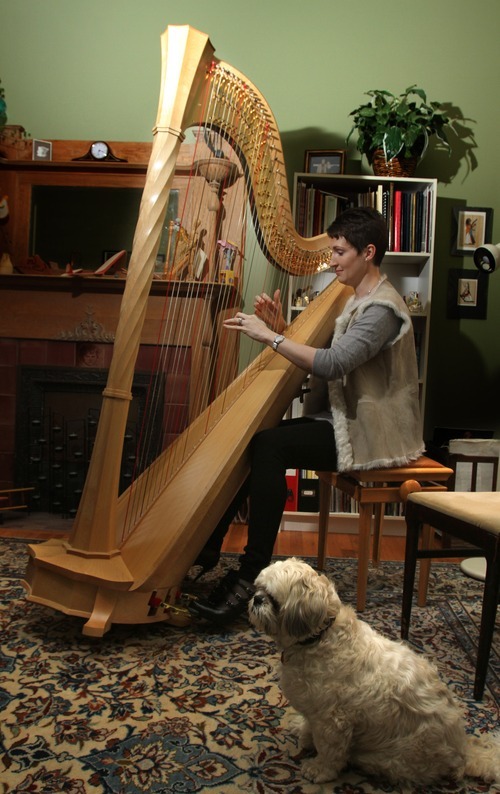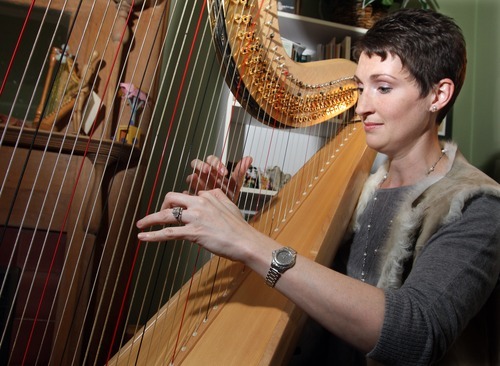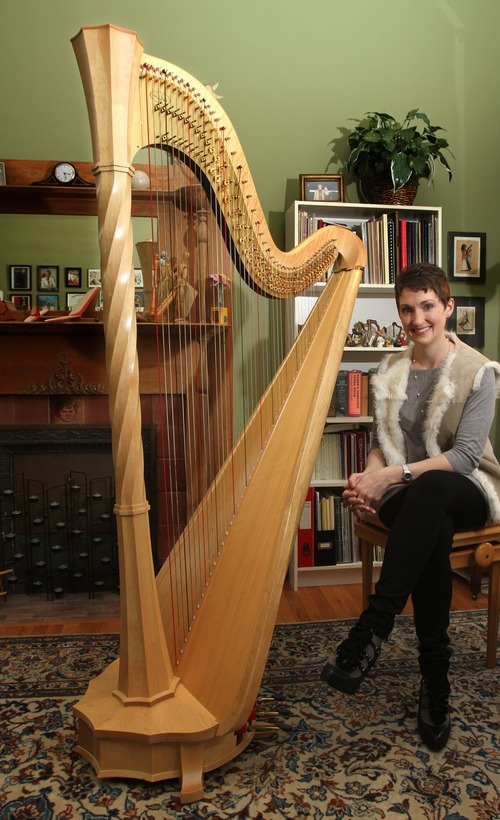This is an archived article that was published on sltrib.com in 2011, and information in the article may be outdated. It is provided only for personal research purposes and may not be reprinted.
Louise Vickerman wants you to discard any notions about the harp as a dainty instrument providing pleasant background music at a garden reception.
"Four Angels," the Mark Adamo concerto that she will perform with the Utah Symphony this week, "is going to change your mind about what the harp can do," said Vickerman, the orchestra's principal harpist. "This is a kick-ass concerto."
The four angels of the title aren't cute little cherubim, but powerful celestial beings: Metatron, the angel depicted in the Kabbalah as being closest to the throne of God; Sraosha, the "angel of divine intuition" in Zoroastrianism; Regina Coeli, the Virgin Mary in her role as Queen of Heaven; and Michael, the archangel common to the Abrahamic faiths.
The concerto follows a traditional framework: an imperious opening movement, followed by a lively scherzo, then a songful slow movement (Adamo has labeled this one "Aria") and a majestic finale. The scherzo movement features unusual musical effects such as a pedal crash — a loud, almost violent sound that results from striking the strings while the pedal that controls the pitch is held between two notches — and a tuning-key glissando, in which the soloist bends the pitch by sliding a metal rod along the string.
Vickerman will be the second soloist to perform "Four Angels." Adamo wrote the concerto for National Symphony Orchestra principal harpist Dotian Levalier, who gave the premiere in 2007.
Early in the work's creation, Adamo visited Levalier and asked her to "tell me everything the harp can do that composers and audiences should know but don't," he said in a phone interview from his New York home.
Adamo wasn't willing to accept the conventional compositional wisdom that it's hard to write for the harp because its sound sinks into the orchestral mix. "I knew I didn't want that graceful, perfumed Sunday-brunch school [of harp music]," he said, "but I didn't know what was possible." Intrigued by what Levalier showed him, he set about liberating the harp from its customary decorative role.
Paradoxically, he said, he achieved this by making the harp part simpler and letting the rest of the orchestra provide the "glittering haze" around it — in other words, writing for the harp as orchestra, and the orchestra as harp.
"Once I'd cracked that idea, the rest came quickly," he said. Drawn by the traditional association of angels with harps, he chose angels as different from one another as possible. He never considered including the fallen angel Lucifer; "to do something that pitch black didn't occur to me," he said. "The second movement gets kind of savage and dark, but it has a playful quality."
Vickerman calls the piece accessible. "It's not avant garde; it's not 12-tone serialism or bizarre stuff," she said. "It has elements of modernity and some unusual things, but it's very tonal. The third movement is absolutely gorgeous — it has one of the most beautiful endings of any piece I've played. I think it will appeal to all audiences, really."
Former Utah Symphony music director Keith Lockhart will conduct the concerts, which also include selections from Bizet's "Carmen" and Stravinsky's complete ballet "Pulcinella." The orchestral suite from the Stravinsky ballet, which the composer based on themes attributed to Giovanni Battista Pergolesi, is a concert mainstay, but it's rare to hear the full score, which includes three singers.
Lockhart hasn't heard a live performance of it, though he has conducted the suite, he said in a phone interview from his Boston home. "I'd always wondered how the rest of it went," he said. "All the parts of the 'Pulcinella' Suite are in there, but expanded. It's so wonderful to see the incredible creativity of Stravinsky, just five years after 'The Rite of Spring,' retooling his vocabulary and launching his neoclassical phase. Only Stravinsky could take Baroque utterances and make them wholly 20th-century. It's a lot of fun."
Catherine Reese Newton is a music critic. Contact her at creese@sltrib.com or 801-257-8616. Twitter: @cathycomma —
'Angels' and more
Principal harpist Louise Vickerman plays "Four Angels," a concerto by Mark Adamo, with the Utah Symphony. Keith Lockhart conducts. Also on the program: selections from Bizet's "Carmen" and Stravinsky's complete ballet "Pulcinella."
When • Friday and Saturday, Jan. 28 and 29, 8 p.m.
Where • Abravanel Hall, 123 W. South Temple, Salt Lake City
Tickets • $15 to $85 (prices rise $5 on performance day)
Finishing Touches • Attend the dress rehearsal Thursday, Jan. 27, at 10 a.m.; tickets are $15.
Also in Ogden • Thursday, Jan. 27, at 7:30 p.m. in Weber State University's Browning Center; $14 to $34; visit http://www.symphonyballet.org.
Learn more • Utah Symphony pianist Jason Hardink will give a free lecture on Stravinsky's music Tuesday, Jan. 25, at 7 p.m. in the fourth-floor meeting room of the Salt Lake City Main Library, 210 E. 400 South. Also, Lockhart and Adamo will give preconcert lectures at 7:15 p.m. in Abravanel Hall's First Tier Room before the Salt Lake City performances.











